
|
|
|
Search our site
Check these out    Do you have an entertaining or useful blog or personal website? If you'd like to see it listed here, send the URL to leon@pawneerock.org. AnnouncementsGive us your Pawnee Rock news, and we'll spread the word. |
Too Long in the WindWarning: The following contains opinions and ideas. Some memories may be accurate. -- Leon Unruh. Send comments to Leon March 2007A photo I like: No. 30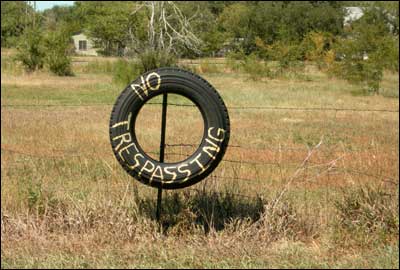
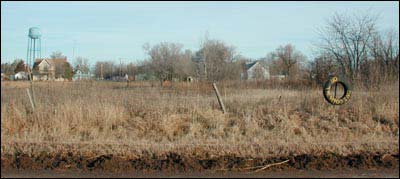
The top photo shows the tire in August 2006. The bottom photo shows the same tire in January 2005. [March 31] I am a fan of things hung on fences: boots, catfish heads, coyotes, and especially tires. Each of these objects has a "real" quality that shows the common-sense approach of the landowner to getting the last bit of use out of life's leftovers -- and, in the case of oversize catfish heads, more than a little pride. Tires last nearly forever and make the best signs. Tires are used almost exclusively for signs that tell you something exactly: "Keep out" or "No hunting" or "No trespassing." This tire hangs on a fence in the southwest corner of Pawnee Rock, on the property lived on for years by Bruce Robinson and his wife. Vote early, vote often[March 30] The Pawnee Rock city election is coming up on Tuesday. The good citizens of our hometown will decide races for mayor and city council, and they'll cast ballots as well for four USD 495 school board seats and for one seat on the Barton County Community College board of trustees. 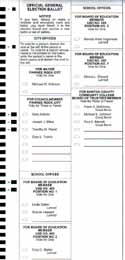 It'll be interesting to see how the possible school sale, the possible move of the city offices, construction around town, plans for revitalizing the town, and personal issues decide the election. We all hope it's a clean but exciting last few days until the election. Mike Kirkman, now a council member, wants to succeed Jack Link as mayor. His is the only name on the ballot. Kirkman's seat on the council doesn't expire this year. If he's elected mayor, someone would have to be appointed to fill his term on the five-member council. Gary Adams, Joseph Billus, Timothy Parret, and Gary Trotnic are on the ballot in an effort to claim the three vacant council seats. The terms of Shane Bowman, Richard Lohr, and Merita Rice are expiring. Besides Kirkman, the other council member who isn't up for election is Walt McCowan. There may be a write-in campaign afoot. Members of the community have been invited to the old school building Sunday evening for a supper to meet possible candidates. Some of the likely write-in candidates have been in the city government before. The candidates whose names are printed on the ballot are asking Pawnee Rock residents to attend the city council meeting Monday evening, also at the school, to meet the candidates. No candidates from Pawnee Rock are in the USD 495 or BCCC races. Another land of beauty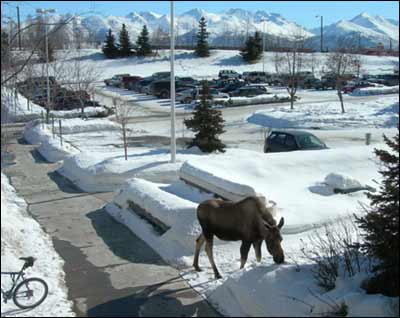
[March 29] You and I grew up appreciating our land of subtle beauty -- the wind washing the grass back and forth, the cattle moving across wide pastures, sunsets to knock your socks off. But once in a while I look around where I live these days and think "Wow." After I got to work in Anchorage yesterday, a bull moose walked up to the employee entrance and started to grind away at the newspaper's shrubs. In the eastern background rise the Chugach Mountains. And the sky was as subtly beautiful as any floating over Pawnee Rock. Remembering Mrs. Chism[March 28] Jeanne Chism used to live with her family in the two-story house on the south side of Pawnee Avenue, a half-block west of the old grocery store. She had several kids -- Charles, Eugene, Erlene, Arlene, and Dwayne -- and she was a protective mother bear. She'd stand on the round porch and make sure her children were treated fairly. Mrs. Chism, as I remember, drove a yellow Beetle, and how she packed her family into it I don't know. She struck me, however, as a determined woman. Eugene Chism left after high school for the Marines back in the '70s, and he died in a training accident near San Diego. It was such a waste for one of ours to die like that when we were just finishing up a war. He, and other family members, are buried in the northwest corner of the Pawnee Rock cemetery. Mrs. Chism, the obituary in the Great Bend Tribune said, had been a caregiver for Rosewood Services. She moved to Great Bend in 1997, and at the end she lived in a rest home in St. John. She died Monday at age 65. Her funeral and burial will be Thursday in Hudson. (Obituary, March 27) Earl Koehn: Earl Koehn, who grew up on the family farm north of Pawnee Rock in the Great Depression, has died in North Newton. He was a son of Lawrence and Martha Schultz Koehn and was 85. He was the manager of the physical plant and the purchasing agent at Bethel College, the Tribune's obituary says. His funeral is Friday in North Newton. (Obituary, March 28) Tracing the right path[March 27] I've been having a lot of fun this month with an online pedometer, checking out mileage from here to there. Go to this site -- www.gmap-pedometer.com -- and tell it to go to your starting city. Zoom in to where you'd like to begin, click on the "start recording" button, click on your starting point, and then click your way down the highway. I traced my path to work (14.1 miles) and around the block (.62 miles), and a lot of others I won't bore you with (but it is 436 air miles from Wichita to Denver). Without going into details, I will also mention that I know how far it is from downtown Pawnee Rock to 10th and Main in Great Bend and from PR to U.S. 56 and Broadway in Larned. I followed the route from Pawnee Rock to Emporia, where my sister lives (157 miles). Then it occurred to me that 157 miles is a nice bit of driving, so I decided to see what that looked like from a different perspective. I started at the Kansas-Oklahoma border on U.S. 83 and "drove" north -- 157 miles took me nearly across the state the short way. Evelyn Unruh Base: Evelyn Unruh Base of Cherry Village in Great Bend died last Friday. Her funeral is this morning in Great Bend, and she'll be buried in Dundee Valley Cemetery. (Obituary on March 24) Mrs. Base, who was a member of the New Jerusalem Church in Pawnee Rock, was born in 1912 and was 94 years old. Her husband was Leo Base; he died in 1979. Her parents were Herman and Lucinda Rudiger Unruh. The classic photo[March 26] Every once in a while I receive or happen across a photo that shouts: "You'll never forget me!" It has strong lighting, dramatic composition, a sense of place, and, above all, intriguing faces. 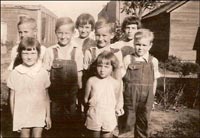 One of those unforgettable photos arrived this weekend in the PawneeRock.org inbox. Pat Croff, who you may know as Pat Wycoff or as Crankygram, delivered the wonderful photo on today's homepage. I asked Pat about whether all the kids who weren't Wycoffs were related to the Wycoffs. They weren't, she replied, and she sent along some details about the others. (The front row is Lila Lee Oller and Pat Wycoff; second row is Glen Jurgensen, Bob Wycoff, Bill Wycoff, and Billy Joe Cheney; back row is Vera Wycoff and Vena Wycoff.) Glen Jurgensen, Pat wrote, "lived in the same building as the drug store, and later moved to Great Bend. I do not remember too much about that family but I do remember that Glen was not nice to me. I was a real scardy cat and he loved to scare me. Billy Joe's folks, at one time, lived in a railroad car. Their dad worked on the railroad. Billy's older sister Cherry (sp?) was a friend of my twin sisters, and I believe she was a nurse during WWII and survived the Bataan march. "Most of the Cheney family moved to California and lived around Hesperia and Apple Valley where their father, Bill, sold real estate when that area started developing. Lila Lee Oller and Mary Frances Grantham were stepsisters. Lila's dad and Mary's mom married. As I remember, it was quite a large family at one time. They lived just south of the Methodist Church. Their home was still there a couple of years ago when we visited Pawnee Rock." Don't those descriptions really bring the kids -- and the Pawnee Rock of that era -- to life? Pat also clarified a photo caption that's in the current page of the Gallery. That wasn't the Class of 1949, she wrote; it was a mixture of years in a class run by Shiela Sutton Schmidt. She also indentified a few of the students, of whom she was one. The photo's title now is "A class with Mrs. Schmidt." Pumped dry: If you haven't been keeping track of the Hutchinson News' superb series on the Arkansas River, now's a great time to catch up with what reporter Amy Bickel has discovered. It isn't pretty. It sounds as if the river's going to stay dry for a long time. "What has happened to the Upper Arkansas in the past 50 years would take a few thousand years to restore," she writes. I found the whole series by using this search on the News' site. If that doesn't work for you, go here and type "arkansas river" in the Google search box at the bottom on the left side of the page (be sure to click on the hutchnews.com button). Elgie Unruh: Happy Birthday, Dad. Election's coming[March 25] The sale of the school seems to be progressing. Maybe. I asked our frequent correspondent Gary Trotnic about the progress of the school sale, more than a month after one company made a bid. "No word on the school yet," he wrote, and the council isn't providing much information to the public. The city election is coming up in a week and a half. Gary's a candidate for the council. He foresees Mayor Jack Link and some current council members having write-in candidacies. "I expect it to be a close race," he says. Consolation music: Leon Miller thinks back to 1957: "Fifty years ago this week I witnessed possibly the most agonizing basketball game in KU history when KU played North Carolina in the finals of the NCAA tournament. The whole basketball world was mesmerized by Wilt Chamberlain and thought it was a sure slam dunk (before such a term became common) that KU would win. "The game was played in Kansas City. I watched the game on TV (black and white) with a girl I was dating at the time, plus her sorority sisters at the Kappa Sigma sorority house on campus. Unbelievably, UNC won in three overtimes. No points were scored in the second overtime. It was a supurb instance of coaching as Frank McGuire, the coach of UNC, brilliantly found a way to stop Wilt and win the championship. "All of us were totally disheartened but somehow word swept through the campus after the game, mainly via the frat and sorority houses, that as a consolation, Louis Armstrong and his band, who had been playing an engagement in KC, would give a FREE concert for the KU students at the KU student union after the game. The dean of students allowed the girls curfew to be extended to 3:00 a.m., and the students descended on the union. "About midnight, Louis and his band were playing when the team came on stage. The crowd went wild! They were humbled by the response and the agony of the loss was tempered by the enthusiasm of those present. My big thrill was being in the same room with two giants on the entertainment industry (Louis Armstrong was, and Wilt would become one of the 'biggest' entertainers ever), cherishing the moment!" Break out the baseballs: The good news is that the next basketball season starts at the end of November. The Jayhawks should have most of this year's team back next year, so things could be pretty good and maybe that season will last two games longer. Let's hope so, or coach Bill Self may become known as the Marty Schottenheimer of college basketball. Schottenheimer, of course, is famous for having great pro football teams in Cleveland, Kansas City, and San Diego but never making to the Super Bowl. All in all, the Sunflower State had a good basketball season. K-State made it to the NIT, and Wichita State got off to a blazing start. And Kansas did beat last year's champion, Florida, and finished 33-5, which is a decent record. We now return you to your regularly scheduled springtime. A photo I like: No. 29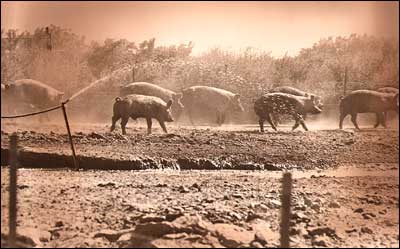
[March 24] A farmer near Larned asked me one summer to photograph some birds roosting on powerlines stretched over his pigpens. He wanted the utility company to move them so bird droppings wouldn't foul the pigs' living area. While I was there, the young pigs started galloping around. Some of the photos in this Saturday series have been selected for their deep psychological meaning. I like this badly kept photo, however, simply because it amuses me to see little pigs frolic. (At least, I hope that's all it is.) Goal tending: As regular readers of this journal know, the Beloved Jayhawks will play the UCLA Bruins this afternoon in the NCAA basketball tournament. KU has never beaten UCLA in the NCAAs. Maybe the fifth time will be the charm. Another guy who would be really happy about a KU victory would be Leon Miller, our Dallas architect. He's a basketball fan from way back: "Speaking of your childhood pickup basketball games -- when I was in my early teens, maybe 14 or 15, I built my own basketball goal in our backyard and practiced and practiced to get good enough to make the team. ANY TEAM. (Which I never did.) "I started out with 2 - 2x4s, laid them on the ground and nailed 1x6s, 4' high and 4' wide, on one end for the backboard, then I dug two holes in the ground and filled them with concrete and set the poles in as I stood the backboard up and attached the top to the eaves of our garage. My parents had given me a basketball goal for Christmas so me and one of my buddies carefully measured 10' from the ground and attached the goal to the backboard. This was probably my first construction job I created, planned and built, and provided many hours of fun for the boys in the neighborhood." Kings of basketball[March 23] In the days when I believed I could be the next Bob Cousy -- I must have been in fifth grade -- I played a lot of basketball in the back yard. 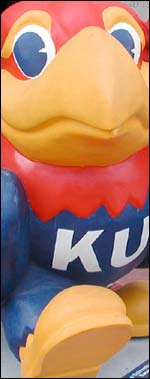 Dad had built us a kid-sized basketball goal on one end of the swingset. There was a wooden backboard and a wire hoop, and over the court hung elm trees. The rim was seven or eight feet above the dirt. My friends and sister and I played endless games of horse: layups, hook shots, jumpers, and 20-foot jumpers where the branches allowed it. The ground had enough clumps of grass to make dribbling unpleasant and uncontrollable, so we passed and shot and were the kings of basketball. As I got older, I wanted what the other kids had: a real rim and net. When we put the rim up, it was astonishingly heavy and large. It was still mounted low enough that on a good day we could touch the rim. A good number of the boys I ran around with had basketball goals at home. Most were bolted onto the garage, above the driveway end. One or two families had goals affixed to old telephone poles -- an open-air game was more realistic except you couldn't charge in for a layup without creaming yourself and there was no garage wall to keep bad shots from rolling across the yard. Televised basketball in those days before cable was not common, but not a rarity either. CBS showed pro games on Sunday afternoons, giving us a taste of the Celtics and Knicks. The real attraction was the K-State games; that seems to have changed little over the past 40 years. When coach Jack Hartman's Wildcats challenged the rich-kid Jayhawks, the gas station would fill up with men and boys who bought pop and made an evening of it. When the Kansas Jayhawks take the court tomorrow to play the UCLA Bruins -- the kings of college basketball when my generation was growing up -- they won't be alone. Dressed now in relaxed-fit jeans and sweatshirts, the Pawnee Rock kids you grew up with will relive their backyard games with every college-boy shot. Too long into the wind[March 22] I was 27 years old when I made my peace with the wind. Until then, the wind was always a nuisance, an irritant; it was nothing but trouble for a guy who ran track and rode his bike and the rest of the time wanted his fishing bobber to sit on flat water. After college, I escaped the wind. I went to work in Austin, at the edge of the Texas hill country. While I was there, I learned to ride uphill, something I had little practice at in Pawnee Rock. The key to my success was to keep a steady pace and attack until my knees snapped and my thighs turned to lead, and then do it again on the next hill and on the next, day after day, until one day I forgot those were big hills. When I returned to Kansas (well, to Wichita) in 1983, I rode hundreds of flat miles a week during the warm weather. I always tried to start around dawn so I could get in most of the miles before the wind came up around 10. For my money, the wind was worse than Texas' hills. In 1984, I signed up for Biking Across Kansas and with 200 others headed east from K-96 at the Colorado border. I somehow acquired the job of leading three or four enchanting high school girls and my brother-in-law, all from around Emporia, through several days of headwind. It was during those long hours of being in front that I came to understand that I would not be beaten by the wind. In the fashion that has stood me well through life, I plodded ahead pedal revolution after pedal revolution, mile upon mile, until the wind lost its ability to irritate me. It pushed and I pushed harder, because I was not going to let my friends down. The wind and I leaned on each other and became companions. I know that a kazillion other people have also defeated the wind and that there are many songs celebrating their struggles. But that doesn't cheapen it for me or for anyone else. It's an achievement we each earn in our own way.
And then this week my sister, Cheryl, wrote about bierocks and posted some pictures (scroll down to March 19). That caught my wife's attention and within a day she had acquired the ingredients and compared Cheryl's site's recipe and one from the "Mennonite Foods & Folkways from South Russia" book by Norma Jost Vost. Last night, I came home from work and walked into a full-blown bierock factory. You'll just have to imagine the smell of fresh bread and the stuffing. I'd offer you some bierocks, but by the time you get here my wife and I will have eaten them all. Hometowns: I got a really sweet message from Rita Wade of northwestern Kansas yesterday. Even though she's never been to Pawnee Rock, she enjoys reading about the town and the situations that we all have in common. Thanks, Rita. Something higher than a kite[March 21] In the spring, our feelings soar like kites over the plains. Or so mine did when I was a kid in Pawnee Rock. I don't know how good you were with kites, but my expectations often flew higher than my kites. Oh, I had fine daydreams of building the perfect T-shape out of pine strips and fitting that white cotton string into the notches and making a handsome tail with scraps of cloth and not tearing the plastic kite body. I expected my kite to rise on the slightest breeze, pulling gently until the line was played out. And that happened, especially on our grandparents' farm northwest of Pawnee Rock, where the breeze arrived unhindered from Texas. My sister, our cousins, and I brought out our Duckwalls kites and unfurled them from around the sticks. (Remember how much fun it was to go to the store and sort through the kite bin?) I think we tried once or twice to make a kite the Cappy Dick way, using newspaper pages and glue, but I suspect that Cappy Dick's readers and their parents were glad when plastic kites became available. We were all better than Charlie Brown at flying kites, thank goodness, but it may describe my experience to say that one of the fastest things in the world is a kite that has turned over and is diving headfirst into a field of green wheat. In the summer after my junior year in high school, I went with the Kansas Lions State Band to San Francisco, where we marched in a parade and generally explored restaurants, Hare Krishnas, and Fisherman's Wharf. My favorite souvenir from America's most exotic city was something I had seen flying over the parks there: a box kite. When I got back to Pawnee Rock, I put the box kite, still in its own orange box, next to my fishing poles on the top shelf in my room. And there it stayed for a dozen years. It wasn't that I didn't like the kite. In fact, I'd occasionally take the box down and admire it. Maybe I was a little afraid of messing up the kite as I built it, thus ruining my souvenir and casting a shadow on the trip to California. There's another possibility: The kite in the box was the last one I bought as a kid. It was a souvenir not only of San Francisco, but also of childhood. The kite in the box was thrown away after Dad and Betty cleaned out my room. They put all the stuff in the basement for me to sort later; maybe I'm the one who eventually sent the kite to the place where it would never fly. Did the kite have a wasted existence? I don't think so. Although I might have had a great time flying the box kite, the kite in the box for all those years served as a symbol of larger things -- adventures I could take if only I wanted to open the box and adventures I was choosing not to take, to my regret. I don't think the story will end here. The wind still blows, box kites are still sold, and there's a new generation of sons who need to learn the thrill of winding in a hundred yards of string. I'll offer them a kite in a box, and they'll decide whether to open it. Rising against the wind[March 20] About 9 last evening I stood in the street outside our home and watched steam pour forth from a volcano about 90 miles away. It was silhouetted by the primrose afterglow of sunset and was quite pretty. Mount Spurr, the volcano at the southern end of the Alaska Range, stands 11,070 feet above sea level and rises from a low base 10 miles from the water, so we can see the mountain for what it is -- a wall of icy rock. Between our house in Eagle River and Spurr is a narrow branch of Cook Inlet known as Knik Arm. What this all means for us is that there are always visible reminders of Earth's elemental forces. The tides come and go twice a day, glaciers define the mountains, and steam rises where magma swells toward the surface. It's a pretty picture. In one way, life here isn't too different from life in central Kansas. Kansas is the playground of wind; unhindered by mountains, giant tides of air shove across Pawnee Rock from the north and the southwest in what we tend to think of as Earth's whims. Storms sweep in from the west, and static flashes between the ground and clouds in charges too powerful to comprehend. In farm and oil country, global economics is like the wind -- we can't see it, but we feel it push our faces and we see the dust devils. Factors beyond our understanding -- we belittle them as the free market's whims -- set the prices for commodities and borrowed money and independent thought. And our families in all the dwindling towns on the plains listen every day to the erosive wind. Hunkered down at home, shoulders bent at work, they watch the cottonwoods bend away from the breeze and the promise of a fair living roll ahead like a tumbleweed. I guess we're all at the mercy of the big winds; it's the way of the world. Yet one day a swelling of ideas and anger could change the scenery. Like the volcano's magma pushing to the surface, a mountain is waiting to be born. A year in the wind[March 19] The sun has risen over the Sunflower State after KU's NCAA basketball victory Sunday. We're two days away from the arrival of spring, and crocuses and daffodils are saying hello. And Too Long in the Wind, my letter about Pawnee Rock, has been going for a year. As always, I deeply appreciate your reading the pieces and sending your thoughts and photos. Everyone's welcome to join the conversation about our hometown. Our readers have answered many of the questions I've raised, although I'm still hoping someone someday will be able to tell me the name of the 1960s TV movie that mentioned Pawnee Rock, Ash Creek, and beer. (More here) For the record, PawneeRock.org is a little older than this column. I launched the site in mid-January 2006. Finally, if you run into my dad, Elgie Unruh, in the next week, please wish him a happy 81st birthday and tell him a funny joke. Basketball heroes[March 18] At 4:06 p.m. today Central time, no one will get between me and the television. In the NCAA tournament, the beloved Jayhawks are playing Kentucky, which is one of the winningest-ever teams and one that owes a lot to Kansas basketball. When I was in college in the late 1970s, Kentucky was ranked No. 1 and came to Lawrence to beat KU on a December night that had been designated Adolph Rupp Night. Rupp, who was born in Halstead and had played for the Jayhawks, had become Kentucky's greatest coach. He died that night at a hospital in Lexington, apparently while listening to the game on radio. As part of my job with the Topeka Capitol-Journal, I got to talk to some of the Kentucky players and listen to the current coach, Joe B. Hall, discuss the game and Rupp. I don't remember the faces so much as I do the feeling of being in a room with basketball gods. So as much as I work myself up for a few hours against Kansas' opponents, I can't hate Kentucky. Those Wildcats are as legendary as our Jayhawks. (Also, I've read that several of Pawnee Rock's founding members came from Kentucky.) High school memories: Leon Miller sent this for our amusement: One of my favorite jokes I love to play on people I meet here in the Metroplex, where we have about 50 Class 5A high schools and an even larger number of Class 4A high schools with the average high school graduating class having 500 to 750 students, is to tell them that I graduated in the TOP 13 of my high school class. They look in amazement and ask, "Wow! How many were in your class?" I then tell them "13." They laugh when they realize they've been had. Speaking of schools: We recently had a gallery photo of an old school. I suggested that it was south of the Darcey place, but I wasn't far enough south or west in my estimate. Susan Unruh Ellis sets the record straighter: Maple Grove school is south of Jim Darcey's corner. Riverside might have been the old school that was 2-3 miles east of the O'Rourke Bridge at the corner where we turned south to Macksville. That school was large, in size, as country schools go. The picture indicates that it is larger than most of the old "numbered" schools, ie. #6 or #9. Remember the remains of the old school just south of Jim Keeley's house at the corner where we turned east to go across the Pawnee Rock bridge? They finished demolishing it about the time we started high school (early 1970s). A photo I like: No. 28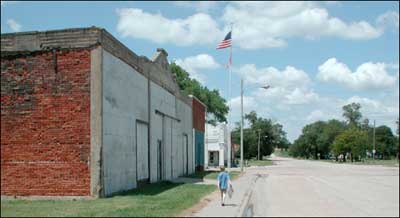
[March 17] One of the best things about Pawnee Rock -- almost any town in central and western Kansas -- is the wide-open feel of the main street. Remember when you were a kid and you walked to the grocery store? Or to the post office? Or the drugstore? OK, if you were going to the drugstore, that was long enough ago that there were trees along the street too. But the street is still a mile wide and it's filled with Kansas air, the lightest air of all. I took this Centre Street photo during the first week of July 2005. Gary Ritchie remembered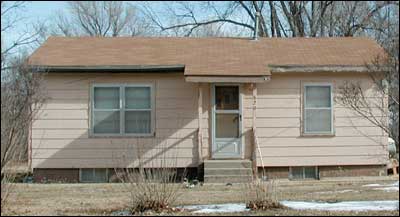 The Ritchie family lived in this home at the intersection of Walnut and Bismark streets. [March 16] Gary Ritchie, who graduated from Pawnee Rock High in 1971, served in the Army, got married and had a couple of kids, worked in construction, and founded the Lone Star Catfishers Group, died a week ago. The obituary yesterday in the Great Bend Tribune said he was 54 and that he died March 8 at his home in Haltom City, Texas, a suburb of Fort Worth. Gary was married to LaWanda Lloyd. He was the son of Ora and Ruth Ritchie and had ten siblings: Ora Jr., James, Harold, Stanley, William, Dennis, Virgil, Christenia, Sondra, and Jeanne. A funeral was held at the Dallas/Fort Worth National Cemetery in the cedar-covered hills of southwestern Dallas County. (Obituary) Class of '49: More names have been added to the photo of the Pawnee Rock Class of 1949. Virgil and Joan Smith joined Leon Miller and Anita Byers in identifying class members. Check it out in the Gallery. Updating a story about selling Pawnee Rock: The 1954 F-600 Ford firetruck was sold via eBay for $3,305.99 to someone identifying himself as truckguy100. The minimum it was listed for was $3,000. The Mennonite parsonage has a contract pending. Reep Real Estate of Larned listed the property. Zum Lobe Gottes[March 15] Our son Nik is working on a story in which he pretends to be one of the Mennonites who left Russia in 1874 and emigrated to Kansas. He and I have been poring over old photos, family memoirs, and the globe. I've shown him the artifacts, including a painted wooden trunk, that were passed down to me.
Nik, who is almost nine years old, doesn't have much historical perspective yet, but when he holds these books he understands that he is moving his fingers across pages touched by Unruhs and Schultzes for at least five generations before his. As an item of faith or of heritage, religious books helped hold our family's colony together as they moved halfway around the world and then splintered across this continent. By the time Nik handed the hymnal back to me, my mind had wandered back to my childhood in the Bergthal Mennonite Church. I was thinking of my Bible -- how I loved the feel of the pages and the cadence of the words, and my name printed in gold letters on the pebbly cover. It was God's word in my hand, but it became a wedge between me and the church. One Sunday evening in the early 1970s our youth group was invited to sit on the sanctuary's stage and ask the congregation any Bible question we wanted. Any question, big or small. I had no trouble coming up with mine. Because the Mennonites called themselves "the peace church" and it was the time of the Vietnam War, I would ask about killing. Why, I asked the congregation, does the Bible say "Thou shall not kill" but it has many stories of the "good" people doing just that? There are sacrifices of offspring, for example, and David killed Goliath, and heaven knows how many people have been slain for the sake of Christianity since then. Implied in my question was my need to know which rules are to be followed and which parts of the Bible are true. A minute dragged by. The Rev. Gerhard Peters repeated the question, and someone offered that the New Testament has a peaceful message. My question lay there on the altar and died. Other kids had their questions, so we moved on. That moment, however, was when my attachment to the church started to unravel. I was disappointed that Religion hadn't solved the question of killing in 5,000 years of Biblical history and that the pacifist Mennonites hadn't figured out an answer in their 450 years of wandering around Europe and North America. In my few years I hadn't asked much of my church, and I was angry that the congregation -- my people -- couldn't help me with the one problem I brought before them. Someday Nik will ask a heartfelt question and fail to get the answer not that he wants but that he needs. I suppose it's a vain hope of mine that I can prepare him to be forgiving in that instance; maybe that's the point at which we all start to make our own path through the world. Tracking fashion[March 14] A couple of days ago I wrote about the start of track season and how we athletes started out in sweats and worked hard for weeks until we got into our uniforms for track meets. Well, my sister, Cheryl, was kind enough to point out that maybe the emperor was not wearing the clothes he thought he was. I had written that we wore singlets, which I understood to be a shirt that's like a tanktop. Cheryl suggested that on the planet on which everyone but me lives, a singlet is what wrestlers wear -- shirt and shorts in a single piece. We were tough kids in Pawnee Rock, but we weren't tough enough to run around the dirt track in a onesie. So, I stand corrected. If I had listened to Cheryl more often, I no doubt would have been better dressed most of my life. The big throw: Also on the subject of track, I got a fun tale from Leon Miller, who graduated from PRHS in 1951. Your article today reminded me of a personal experience I wrote in an autobiography I gave to my kids (not really kids as they are 44, 42 and 39) for Christmas this last year. The story goes like this: As our school was small and athletics was a very important part of our lives, I longed to get my high school "letter" and be able to walk around with my buddies and show off. Alas, this was not to be as I was not big enough or fast enough for football, nor was I skilled enough for basketball. I was in my senior year and nearly to graduation and still had not earned my letter. I went with the team to all the events we participated in but was never asked by the coach to "GO IN." Then in the spring of 1951, at a track meet of the South 50-6 League, I unknowingly got my chance. The coach came up to me and said, "Miller, you're going to represent Pawnee Rock in throwing the discus." WHAT?! I'd never thrown the discus in my life, let alone doing it now in the biggest event in the league! Nevertheless, I agreed to give it a try. We had three chances to perform. On the first try I threw it about 15'. When my turn came around again I threw it maybe 20'. On the last try it couldn't have been more than 25'. But, hanging my head, I went back to the bench and waited for the events to be over. I was so embarrassed! Then as the announcer read off the list of winners in the events, he came to the discus. I was barely within hearing distance as I heard him say, "Third place winner in the discus, LEON MILLER, PAWNEE ROCK"! Wow! How could that be? As it turned out, there were only three people entered in the discus and I got my letter! Pawnee Rock & Clarence townships[March 13] The focus always seems to be on when this town or that county or the other state was created. Townships, the local governing bodies for all the space between towns, are lost in the historical fog. But here we have a look at the founding of Pawnee Rock and Clarence townships. Pawnee Rock Township occupies the 36 square miles in the southwestern corner of Barton County, and Clarence Township comprises the 36 square miles immediately to the north. Pawnee Rock Township covers the three miles east and west of Pawnee Rock (measured from the Mennonite Church road, or SW 110th Avenue), plus six miles north to SW 10th Road. Clarence's southern edge is at SW 10th Road. The northern edge is a mile south of Albert. Here are historical details taken from the "Biographical History of Barton County, Kansas," published in 1912: Pawnee Rock TownshipThe first settlement was made in this township when the Kentucky colony, consisting of twenty persons arrived. In the party were T. C. Polk, John W. Smith and George M. Jackson, who was the leader of the colony. Mr. Jackson first located near Ellinwood but at a meeting which was attended by all the members of the colony it was decided that the land in Pawnee Rock township was the best to be found in the county. Accordingly it was decided that they would take up their land there. On March 23, 1872, a celebration was held in honor of their arrival at the historic pile of stone known as Pawnee Rock. In addition to those already named the following were among the first settlers in this township: Will. C. Hatter, Dennis Logan, S. P. Leitner and D. M. Sutherland. In 1874 the following were added to the township's population: W. M. Jenks, F. J. Jason, Charles C. Lewis, Eli, Wm. H. and Hiram Bowman, Robert J. Smith, Aaron F. Miller, Joseph Hanon, John W. Graves, John Ren, Isaiah Pelsor and J. F. Pearce. This township now has a population of 356. Settlement was begun in this township early in 1872. Among those who selected claims were the following: In 1872, Wm. Hartshorn, Ed. Tyler, Luther Frost, John McMullin, Evan Thornberg, Nelson H. Richie, Willis M. Howerton, Henry Fruit, Eliza Hartshorn, Wm. H. McGreevey, John H. Doel, Joshua Lyle. In 1873, Charles B. Rose, Andrew J. Acton, George N. Welch, Oscar O. Hartshorn, Wm. H. Quincup, Frank Sheldon, Thomas Keenan, and in 1874, Sample S. Sanford, John Lyle and Lorenzo Leach. That portion of the township known as Washburn precinct was settled in 1874 by A. C. Barnes, Wm. Hayes, Vincent Coale, Samuel H. Mitchell, Chas. B. Morgan, Robert M. Shields, Wm. Dunn and Wm. R. Julian. This township now has a population of 387. Clarence TownshipT. S. Morton was the first settler in Clarence township and he located on section 14, in 1871. He first engaged in the cattle business but he soon gave it up for farming. Daniel Curry and E. M. Chapman located on section 14, in 1873. Julius Both settled on section 20 in 1872 and for the first few years after his arrival was one of the best known and most successful buffalo hunters in this part of the country. In the same year John Bennet and L. S. Pursell settled on section 30. They were soon followed by T. J. Byrne. During the same year D. C. Stephens, G. S. Bennet and T. F. Craig located on section 20, and by the fall of 1873-4 that part of the county was well settled and farming was in full swing. Two of the largest wheat growers in the county were added to Clarence's population in 1874. They were Robert Campbell and Joseph Patterson. Mr. Campbell located on section 14 while Mr. Patterson located on section 17. By 1876 there was no unoccupied land in the township and it had three good schools, the first having been built in 1874 on section 20, the second in 1875 on section 11 and the third on section 34 in 1876. The following names are found among those who settled in this township in the early days: W. A. Chapman, David Curry, David C. Stephens and W. H. Brown in 1873; Peter Schlim, Almon M. Button, Wesley E. Loomis, M. F. Campbell, Geo. S. Bement, Tammen C. Tammen and Isaac Goatley in 1874. During the year 1875 the following settled in Clarence township: Wm. Morris, Jas. K. Grier, Mahala Allison, John H. Rhodes and Thomas Irons. The township now has a population of 374 and contains within its borders rich, fertile and well cultivated agricultural land. Goodbye, basketball. Hello, track.[March 12] Sooner or later, like it or not, high school basketball season has to end. And when it does, boys and girls head outdoors to start practicing their track and field skills. For kids in my era, that meant putting on cotton sweats and track flats -- thin shoes with no heels or arches -- and running through the streets of town. A few of us actually did run; in truth, I suspect it was a way for the coach to get the boring distance runners of out of his way while he worked on the flashy sprinters and pole vaulters. It would be a month before we could become thinclads -- for track meets, we wore silky blue shorts and white singlets with yellow lightning bolts. I think we all missed basketball, but the arrival of track and field meant that (1) we'd be outdoors with the girls track team (you know the spring connotations involved there) and that (2) the end of the school year wasn't far off. As I look back at those seasonal switches, it also seems that there were psychological changes: • Basketball is a sport of harvest. The game, after all, began as a way of putting balls into peach baskets. • Basketball is a sport of compression. The game's whole point is to move toward the basket to score or get rebounds. • Basketball players run very short distances, starting and stopping on a dime. In practice, players run wind sprints, which teach them not to run like the wind but to build their wind. • Basketball is a team sport played in a gym. Closely packed fans focus their energy inward toward players on a small court. • Track is a sport of spreading out. The whole point is for individuals to shoot from the starting point faster, farther, or higher. • Track is like spring weather: You want to run like the wind. And the other half of the sport is field: The name itself conjures images of green grass and growth. So when you see a track team running through town this month, give 'em a wave. Those kids in sweats are the very symbol of spring. What will be the matter with Kansas? It should be noted that the Kansas Jayhawks are one of the top four teams in the NCAA men's basketball tournament. But after the past two disappointing March Madnesses, will any Kansan filling out a bracket for the office pool pick the Jayhawks to survive past the first round? Oh, all right. I will. Hope never dies. Name those kids: Several of the students in the photo on yesterday's homepage have been identified. The Class of '47 is now in the Gallery -- and we still need a few names. Chuck Jelinek: Janis Zeiber Jelinek sends an update of yesterday's item about her son Chuck, who suffered a major heart attack a week ago and was on life support: "Happily, Chuck has come back to us. I talked to him twice yesterday and twice today. The Dr. is going to do more evaluation tomorrow and maybe put a stent in." Mail from all over[March 11] I got a nice note yesterday from Jerry Allen, who lived in Pawnee Rock from 1975 through 1988. He writes: "I have lived in many places and fondly think about PR, wheat harvest, and the wide open space that exist there. I worked for Mull's for a while and Farmer's Grain for 6 yrs and Radium Coop for 4 yrs. I now live in Greenville, SC, due to a job transfer. We plan on moving back out to the mid-west after I retire. "I have one of the PR belt buckles if any of the hometown folks are interested in acquiring one. I can be contacted at: Jerry Allen Janis Zeiber Jelinek: Janis Jelinek wrote from Harlingen, Texas. Her son Chuck, who was in my kindergarten class, recently had a heart attack. Let's take a moment and send a kind thought his way. In addition, Janis wrote: "I saw your picture of the dedication of the state park. My grandfather, Wilson Zieber, donated and planted the trees which still surround the Rock. He started a nursery in Pawnee Rock in 1885." At the turn of the century, the Ziebers had a large nursery -- the Pawnee Rock Nursery & Stock Farm, just east of town, in the acreage northeast of where the road extended from the cemetery meets the highway. It's a good guess, I think, that the old elms around town came from Mr. Zieber. 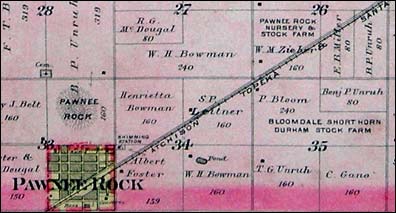
Wilson M. Zieber had a nursery east of Pawnee Rock, as recorded in the 1902 Barton County plat book. Pat Croff and Mary Frances Jackson: Pat Croff of California wrote that she and Mary Frances (Grantham) Jackson had been comparing notes about photos from the "olden" days in the Gallery. Pat, whose address is in Friends of Pawnee Rock, lives in California, and Mary Frances lives in Louisiana. Improvements: One of the hurdles to putting together a site like PawneeRock.org is identifying people and places in the photos that appear on the site. Sometimes I come across a photo that doesn't have any identification on the back. I put the image on the site with the best caption I can, and the standing invitation is for anyone with better information to send it to me so I can share it with everybody.
Several months ago, Glen Grunwald identified the players from memory, and now Edward has come across the page and fixed a pair of names. Between them, Edward and Glen Grunwald have provided an accurate caption, and I'm grateful to both of them. What it comes down to is this: We welcome photos and anecdotes, and the more the merrier. The same goes for fixing details. The more information we collect, the more accurately we can describe life in Pawnee Rock. Thank you, everyone, for your help. A photo I like: No. 27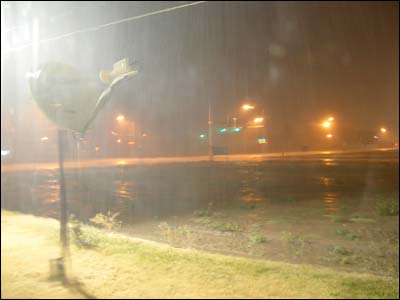
[March 10] I know thunderstorms and gullywashers are a dime a dozen in the central Kansas summer, but I had not been in one for several years. This one -- great buckets of rain illuminated by lightning bolts -- fell when I was tucked into the Days Inn on 10th Street in Great Bend. I'm sure you can imagine how fresh the breeze was before the rain arrived on this hot night, and how good the mud smelled afterward. That's our Kansas -- bake hard, then bathe hard. The birth of the cemetery[March 9] It's a favorite drive to visit the Pawnee Rock Township cemetery just north of town. For many of us on bicycles, it was the next big destination after we got up the Rock and the hill by the Rock. The cemetery represented the boundary of Pawnee Rock; go any farther west and you would have slipped into farm country.
As we walk through, we see names of families we might never have met -- the Logans, the Wises -- but they were important to Pawnee Rock long before the cemetery was shaded by cedars and before familiar peonies and lilacs perfumed the spring air. And before that, imagine back to when the cemetery was created from land held fast by prairie grass and wildflowers. It probably didn't take long after the first families arrived in the early 1870s that the need arose; life could be short and harsh, and farm families might lose as many infants as survived. Whose land would be given for the cemetery? As it happens, two families shared the cost and honor. The site for the cemetery was chosen to be north of the section line -- marked by the road -- and at the center of the section. The western half of the cemetery came from the F.T. Belt family, and the eastern half came from the family of Benjamin P. Unruh, who also owned Pawnee Rock before it became a park. (Go to the Big Pictures Gallery to see a plat of the whole Pawnee Rock Township.) Francis T. Belt, a Union cavalry veteran from Missouri, was buried in 1914; you can find his grave next to the big white marble stone near the entrance to the cemetery. He's flanked by members of his family; to his left in the photo is the marker for Mary Belt, who owned the land south of the cemetery and immediately west of the Rock. Benjamin P. Unruh, born in Russia in 1850, was buried in 1929. His grave is under the trees just north of the cenotaph and cemetery directory. 
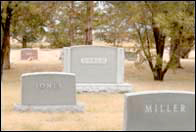
Left: The grave marker of the Francis T. Belt family. Francis's grave is indicated by the GAR marker; daughter Mary's grave is just to the left. Right: The Benjamin P. Unruh family plot is north of the cenotaph and under the trees in the Pawnee Rock Township cemetery. Snapshots of the times[March 8] Larry Mix of the Santa Fe Trail Research Site passes along one family's genealogy page that might interest Pawnee Rockers. One of the family members, Harry Altenberg Hanes, was a carpenter who worked his way across Kansas and lived with his family for five years in Pawnee Rock. If your house or buggy was built around 1907, Alt Hanes may have had a hand in it. "While in Pawnee Rock, Alt was a carpenter," this family's historian writes. "Apparently he worked at the Eckhart Buggy Company and the Auburn Automobile County." (I don't know whether the buggy company and auto shop were in Kansas.) There's a photo of the Hanes family at the Rock. Scroll down on this page to find it. Frank Sihler, who I wrote about last week, ran into trouble early in the Iditarod sled-dog race and decided to pull out rather than risk hurting his dogs on a nasty stretch of trail as a storm settled in on the Alaska Range. You can read more about Frank here.
My grand total since the quarters were issued in the fall of 2005: Five. In the meantime, the Texas Lone Star quarters go to Nik, who was born there. I split the Indy-car Indianas between the boys, and we try to collect a pair of quarters from each state for posterity. Everything else goes in the Coke machine. Do you know these people? It has been a while since we visited myspace.com to see how the youth of American are coming along. Here's a look at myspace members who mention Pawnee Rock. The life cycle of brittle snow[March 7] The two feet of snow on the ground where I live now has been there since November. It has been packed down by its own weight, thawed for a day or two and refrozen into concrete, and recently sucked dry by the wind. The brittle snow is dead. When a warm wind comes along one day later this month, the snow will disappear as fast as Frosty. Sometimes I wonder whether a town can be brittle too. The brittleness might show up in houses that aren't cared for or that are abandoned, or in neighbors who judge, or in oldtimers who shun newcomers. It might show up in secretive government. It could be in trees that aren't trimmed or that aren't replaced when they die. It could be in people thinking the town is too old to be young again, that the town might as well die when they do. Right now, more snow is falling in my town, and we are expected to get up to a foot over the next day or two. The dirty snow will be replenished and we'll get a little more time to ski. But no matter how much snow falls, we can see the end of winter from here. Spring will come. The snow will change forms and the water will replenish the land. We don't have to do anything but wait out winter. A town that's like old snow, however, has to choose what to do when the south wind rises. Will it let itself disappear, sucked into the drying breeze? Or will it welcome the change in seasons and help new life grow? Where imagination can branch out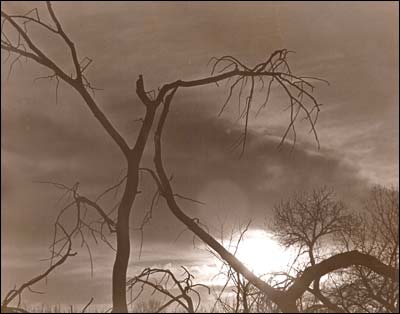
[March 6] During the warm months in Pawnee Rock, I liked to go fishing in Ash Creek and the Arkansas River near the Point. When the leaves fell and after the hunters were through, I went back just to walk around. It was rare enough on the prairie to have our own forest, a different ecological zone where you might more easily find the creatures from storybooks: raccoons, deer, songbirds, odd spiders. The air at the Point was just different. There was running water nearby and tall cottonwoods, of course, so it was often more humid than back along the low Smoky Hills. But there was more to it than that. The leafless trees, with their twisted arms, and the blown-down cottonwoods, with their barkless flanks, created an ethereal world built for teenage daydreams that mixed Walter Mitty with Daniel Boone with Romeo and Juliet. On chilly days, a kid dressed in his jeans and plaid CPO jacket could explore the land and heroic storylines at the same time. Sometimes the trees come to mind now when I see the enchanted forest in "The Wizard of Oz." But our forest wasn't vicious. It welcomed me in and gave my imagination the run of the place. School deal or no deal? Gary Trotnic wrote Monday night with news that the city council was still awaiting final word from the potential buyers of the school. He wrote that "they came down and took a lot of pictures and video. I guess they have until this fri. to made up their mind. Guess they can back out at any time." Nothing to do with Pawnee Rock, but everything to do with being a dad: Eight-year-old Nik was messing around with a still camera and the computer last night and made this Quicktime movie all by himself after my wife explained the process to him. He used 146 individual flash photos and some of his 150 Playmobil figures. If you need me in 25 years, I'll be at the Oscars watching Nik hold up his statue. A little chicken[March 5] A member of the king's court stole some money, but he wouldn't confess and say where he had hidden the loot. The king threatened him to no avail. Finally, as the executioner was swinging the ax, the count screamed, "Stop! I'll tell!" But it was too late. The moral: Never hatchet your count before he chickens. That joke is forever associated in my head with Hannibal, Missouri, which is where we were when I read it in Boy's Life. Our family was on the way to pick up Pawnee Rock's new school bus in the late 1960s, and I think this joke made such an impression on me because it was the first complex pun I understood. But Hannibal isn't the only association my mind makes. The other thought that comes unbidden is Grandma Unruh chopping the heads off chickens in her yard. And that makes me think of her henhouse and of collecting eggs. 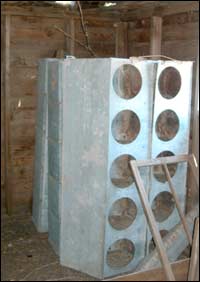 A henhouse, as you may remember, is a dusty, poopy place filled with ammonia fumes -- and with hyper-reactive birds with sharp beaks. Grandma had no problem sticking her arm under the chicken and pulling out the eggs. She did it once or twice a day. But we grandkids saw it differently. The chickens roosted at night on two-by-fours stretched across one side of the chickenhouse. On the three other walls were windows and metal nests lined with straw. Each set of boxes had top and bottom rows with a circular opening. The chickens sat in there, beak facing outward, when they laid eggs. (The photo shows the nests in storage in 2006.) I was repulsed by the notion of reaching under a chicken's bottom and feeling around until I found an egg. I wasn't happy about it, and neither was the chicken. A kid's forearm is a sensitive thing, as the hens proved time and again. I won't say that chickens can smell fear, but I wouldn't put it past them. It might be their only higher brain function. Eventually we got the eggs and carried them over to the root cellar, where Grandma kept them cool and we counted them into cartons. Some would end up in Grandma's cooking, and our families bought the rest from her at 25 cents for a dozen or some such bargain price. Grandma didn't care much for hatching eggs, although she had no problem at all hatcheting chickens. And I ate them gladly. The postcard is returned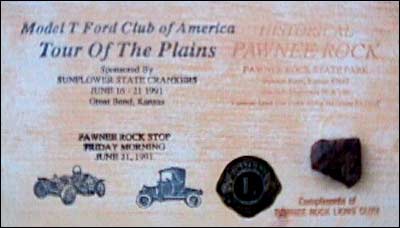
[March 4] Larry Mix, who with wife Carolyn operates the Santa Fe Trail Research Site, wrote that he was shopping in Kinsley and found a wooden postcard. The card was produced by the Pawnee Rock Lions Club in honor of a Model T car club's Tour of the Plains, which was coming through town in June 1991. A small piece of rock was glued to the card. Well, Larry sent a photo of the card to the right place. Elgie Unruh made the cards, part of his artistic endeavors with wood. Larry didn't get the photo of the card to work out, so he included the wording stamped on the card: Model T Ford Club of America City council: The possible sale of the Pawnee Rock school and city building goes before the city council tomorrow night. The city has accepted a bid and sent the contract back to the would-be buyer, Mayor Jack Link said recently, so it'll be interesting to see whether everything's on track for the sale. If the deal goes through, Monday's meeting could be the last monthly city council meeting in the school. 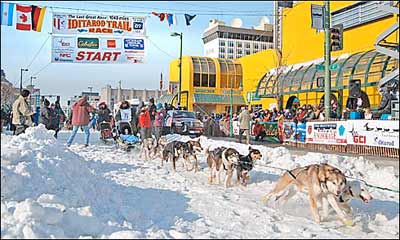
Go, dog, go! The Iditarod Trail Sled Dog Race is making its start this weekend, signaling the beginning of the end of winter. "My" musher, Frank Sihler, for whom my wife and I are running a website, invited me into the staging area to photograph his team as it got started Saturday morning in downtown Anchorage. In Kansas, this would be like being invited to be a ball boy at a Jayhawk basketball game. The Iditarod is the classic Alaska event: In a state with snow, dogs, loners, and unimaginable distances, long-distance mushing is the perfect sport. The best mushers are heroes like Jim Ryun was during his running days. Yesterday was a ceremonial first leg -- a warmup lap -- to show off for the TV cameras and for the folks in Alaska's biggest city. Today, the race begins for real at a Pawnee Rock-size town an hour's drive north of Anchorage. The dogs are trucked from Anchorage to Willow and will start the real run to Nome this afternoon. The huskies are happy to run, and with more than a dozen of them pulling each sled at 7 or 8 miles an hour it's not too much of a strain. Imagine -- a dog with a purpose in life. A photo I like: No. 26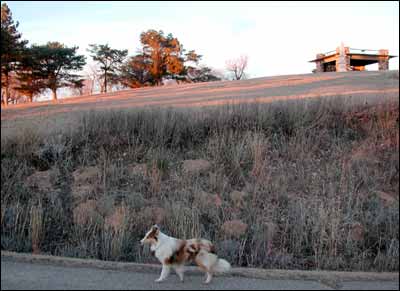
[March 3] It's pretty common in Pawnee Rock to share the street with a dog, but even that has its surprises. When I was at the Rock one evening, I watched this sheltie walk up the road right past me without a glance in my direction. The dog knew where it was going, which was all the way around the Rock. That's one of the great things about Pawnee Rock and towns like it. Whether you're a dog or a human, you can set your mind to do something and not have to pay attention to anything else unless you're about to get run over. I don't think it's carelessness or indifference, and it's more than just wearing blinders. It's a feeling of unity with the world. Tornado education
Pawnee Rock school kitchen, 2006. Kids on their way to the tornado shelter entered through the door on the left (the counter used to stretch all the way across) and walked past and behind the stove to the basement stairs (pink photo). [March 2] It's only natural for us to imagine what it was like inside the school Thursday afternoon in Enterprise, Alabama, when the tornado arrived. The kids on their knees in the hallway, the roar, the flying glass, the collapsing brick wall. The loss. The hugs for the frightened survivors. 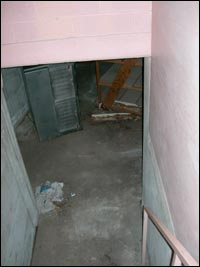
Our high schools, both the Rural and Pawnee Rock HS, were on the western side of town, the side most likely to get kicked first by a tornado as it arrived. I don't know what it was like in the Rural school, but I doubt that there's a kid who went to Pawnee Rock schools from 1956 on who doesn't remember tornado drills and the hurried but calm walk to the kitchen and down the stairs into the basement, where we stood among the civil defense barrels and waited for the all-clear sign. High schoolers, if I remember right, walked down into the boiler room, between the kitchen and the gym. Those are fine hidey-holes when there's enough warning. And I think that was our advantage over folks in distant states. I'm pretty sure we all knew the warning signs -- green sky, churning clouds -- of a tornado in the making. We also had the advantage of an uncluttered view toward the southwest, the direction a tornado would come from. We paid attention. We were no fools. We had seen what happened to Dorothy and Toto when they didn't get in the cellar. Still, there were times I thought the principal was being careless with our lives. On some spring days the clouds were so low and dark, the lightning so close, and the thunder so chest-shaking that I'd rather have spent the afternoon underground than behind the metal shutters and big windows of fourth grade. We were fortunate, all those years, not because of anything we did but because the conditions just didn't bring us a tornado. Had trouble spun out of the clouds, however, we were as prepared as we could be. Yesterday I wrote about a cottonwood tree along the county road on the southern edge of town. Leon Miller, who grew up one house north of that road and a couple of blocks west of that tree, sent this note: "For as long as I can remember this tract of land didn't produce much of anything in the 1940s and '50s. The farm across the road on the south side belonged to a fellow named Charles Inderweisen. He owned the whole section that extended east to the road leading to the Arkansas River bridge and west to the north/south road that now goes by the Keith Mull feed lot. The first and only time I saw a wheat thrashing operation, sometime in the late 1930s, was on the Inderweisen farm. That must have been the last vestiges of harvesting wheat by this method as the combine came along soon afterward and farmers didn't thrash their wheat crop anymore. "Immediately east of the intersection you describe in the picture was a long shelterbelt that was planted in the Franklin D. Roosevelt era. As a teenager I remember walking out the back door of my house and heading down to the shelterbelt to hunt quail, pheasant (in season of course), rabbits, squirrels and anything else that piqued the interest of the typical rural teenager. "It's funny, though, that tree in your picture is not a significant memory to me. Maybe it was a sapling 60 years ago." The southeast cottonwood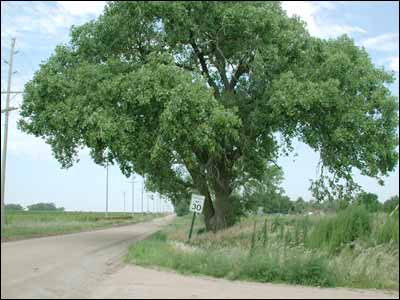
This cottonwood welcomes families back to Pawnee Rock. [March 1] The cottonwood rises 40, maybe 50 feet over the sandy county line road on the edge of Pawnee Rock. For all my life -- perhaps for as long as any Pawnee Rocker has been alive -- this rough-barked tree has marked the southeastern corner of town. The land on its block is partly farmed, partly vacant, partly an old machinery storage yard. A farm sprawls out across the road to the south. The emptiness adds to the tree's majesty, a stalwart against the south wind coming across the lowlands from the river. When the tree was planted, Pawnee Rock must have been in its infancy, or at least in its toddler years. Was the tree then part of a shelter belt for the Brewer property, or were there grand plans for a promenade? Maybe it was a just a way of staking out a piece of property -- a townsite -- where emptiness stretched a long way. |
Sell itAdvertise here to an audience that's already interested in Pawnee Rock: Or tell someone happy birthday. Advertise on PawneeRock.org. |
|
|
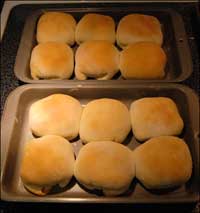 Bierocks: A few weeks ago I began craving bierocks, those succulent helpings of burger, onion, and cabbage baked inside dough.
Bierocks: A few weeks ago I began craving bierocks, those succulent helpings of burger, onion, and cabbage baked inside dough. 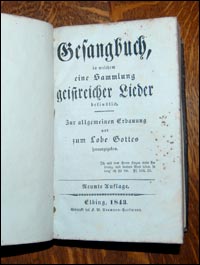 To help him understand the Mennonites' desire for religous and economic freedom, I pulled a couple of German-language hymnals off the shelf. The heavy book printed in 1843 is crammed with four-leaf clovers pressed between its pages; the book with "1872" stamped on its cover is otherwise undecorated but rests in a protective box. "Zum Lobe Gottes," the title pages say: "To praise God."
To help him understand the Mennonites' desire for religous and economic freedom, I pulled a couple of German-language hymnals off the shelf. The heavy book printed in 1843 is crammed with four-leaf clovers pressed between its pages; the book with "1872" stamped on its cover is otherwise undecorated but rests in a protective box. "Zum Lobe Gottes," the title pages say: "To praise God."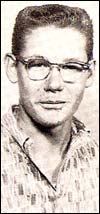 That came up this weekend when I got a couple of helpful e-mails from Laurie Chapman, formerly of Radium and now of Florida, and her father, Edward (Class of 1965; class photo as a sophomore in 1962-63). In looking through our Gallery, Edward found that a 1962 basketball team photo had misidentified him and another boy.
That came up this weekend when I got a couple of helpful e-mails from Laurie Chapman, formerly of Radium and now of Florida, and her father, Edward (Class of 1965; class photo as a sophomore in 1962-63). In looking through our Gallery, Edward found that a 1962 basketball team photo had misidentified him and another boy.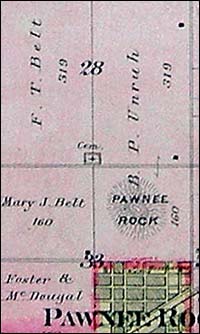 The cemetery, there on that one-mile stretch of asphalt, has been part of Pawnee Rock since the beginning. The oldest stones carry pioneers' names and epitaphs such as "Born in Russia." A couple of notable stones are just that -- chunks of our color-of-dried-blood Dakota sandstone.
The cemetery, there on that one-mile stretch of asphalt, has been part of Pawnee Rock since the beginning. The oldest stones carry pioneers' names and epitaphs such as "Born in Russia." A couple of notable stones are just that -- chunks of our color-of-dried-blood Dakota sandstone.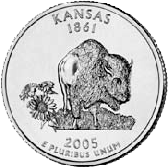 Kansas quarters: On October 1 and again on November 19, 2006, I noted my bad luck in getting a Kansas quarter in change. My fortunes have changed -- a little. Six weeks ago I was handed a Kansas quarter when I bought a cookie for one of my boys at Starbucks. I've put off mentioning it because I didn't want to admit being in a Starbucks; I don't even drink coffee.
Kansas quarters: On October 1 and again on November 19, 2006, I noted my bad luck in getting a Kansas quarter in change. My fortunes have changed -- a little. Six weeks ago I was handed a Kansas quarter when I bought a cookie for one of my boys at Starbucks. I've put off mentioning it because I didn't want to admit being in a Starbucks; I don't even drink coffee.